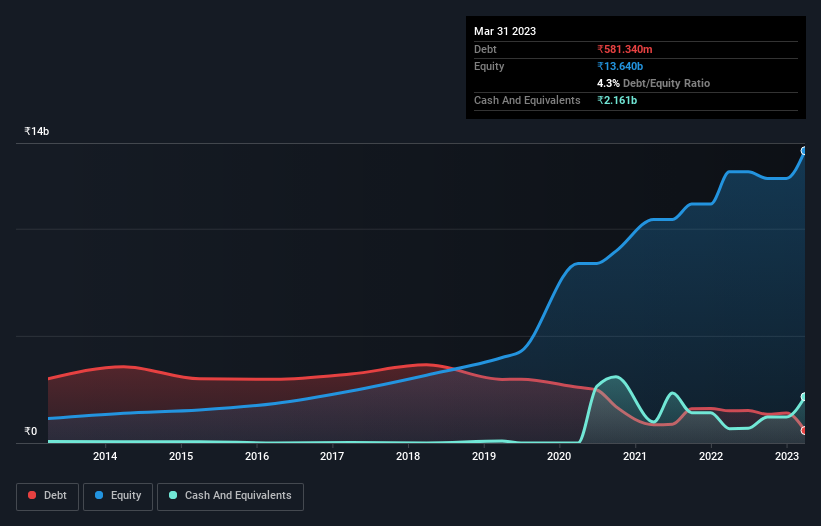Is Prince Pipes and Fittings (NSE:PRINCEPIPE) Using Too Much Debt?

Legendary fund manager Li Lu (who Charlie Munger backed) once said, 'The biggest investment risk is not the volatility of prices, but whether you will suffer a permanent loss of capital.' So it seems the smart money knows that debt - which is usually involved in bankruptcies - is a very important factor, when you assess how risky a company is. Importantly, Prince Pipes and Fittings Limited (NSE:PRINCEPIPE) does carry debt. But is this debt a concern to shareholders?
When Is Debt A Problem?
Debt is a tool to help businesses grow, but if a business is incapable of paying off its lenders, then it exists at their mercy. Ultimately, if the company can't fulfill its legal obligations to repay debt, shareholders could walk away with nothing. However, a more common (but still painful) scenario is that it has to raise new equity capital at a low price, thus permanently diluting shareholders. Of course, plenty of companies use debt to fund growth, without any negative consequences. The first step when considering a company's debt levels is to consider its cash and debt together.
See our latest analysis for Prince Pipes and Fittings
How Much Debt Does Prince Pipes and Fittings Carry?
The image below, which you can click on for greater detail, shows that Prince Pipes and Fittings had debt of ₹581.3m at the end of March 2023, a reduction from ₹1.50b over a year. But on the other hand it also has ₹2.16b in cash, leading to a ₹1.58b net cash position.

A Look At Prince Pipes and Fittings' Liabilities
Zooming in on the latest balance sheet data, we can see that Prince Pipes and Fittings had liabilities of ₹4.60b due within 12 months and liabilities of ₹305.0m due beyond that. On the other hand, it had cash of ₹2.16b and ₹4.16b worth of receivables due within a year. So it actually has ₹1.41b more liquid assets than total liabilities.
Having regard to Prince Pipes and Fittings' size, it seems that its liquid assets are well balanced with its total liabilities. So it's very unlikely that the ₹78.1b company is short on cash, but still worth keeping an eye on the balance sheet. Succinctly put, Prince Pipes and Fittings boasts net cash, so it's fair to say it does not have a heavy debt load!
It is just as well that Prince Pipes and Fittings's load is not too heavy, because its EBIT was down 52% over the last year. Falling earnings (if the trend continues) could eventually make even modest debt quite risky. When analysing debt levels, the balance sheet is the obvious place to start. But it is future earnings, more than anything, that will determine Prince Pipes and Fittings's ability to maintain a healthy balance sheet going forward. So if you want to see what the professionals think, you might find this free report on analyst profit forecasts to be interesting.
Finally, a business needs free cash flow to pay off debt; accounting profits just don't cut it. While Prince Pipes and Fittings has net cash on its balance sheet, it's still worth taking a look at its ability to convert earnings before interest and tax (EBIT) to free cash flow, to help us understand how quickly it is building (or eroding) that cash balance. Looking at the most recent three years, Prince Pipes and Fittings recorded free cash flow of 29% of its EBIT, which is weaker than we'd expect. That's not great, when it comes to paying down debt.
Summing Up
While we empathize with investors who find debt concerning, you should keep in mind that Prince Pipes and Fittings has net cash of ₹1.58b, as well as more liquid assets than liabilities. So we are not troubled with Prince Pipes and Fittings's debt use. There's no doubt that we learn most about debt from the balance sheet. But ultimately, every company can contain risks that exist outside of the balance sheet. For example - Prince Pipes and Fittings has 2 warning signs we think you should be aware of.
At the end of the day, it's often better to focus on companies that are free from net debt. You can access our special list of such companies (all with a track record of profit growth). It's free.
New: Manage All Your Stock Portfolios in One Place
We've created the ultimate portfolio companion for stock investors, and it's free.
• Connect an unlimited number of Portfolios and see your total in one currency
• Be alerted to new Warning Signs or Risks via email or mobile
• Track the Fair Value of your stocks
Have feedback on this article? Concerned about the content? Get in touch with us directly. Alternatively, email editorial-team (at) simplywallst.com.
This article by Simply Wall St is general in nature. We provide commentary based on historical data and analyst forecasts only using an unbiased methodology and our articles are not intended to be financial advice. It does not constitute a recommendation to buy or sell any stock, and does not take account of your objectives, or your financial situation. We aim to bring you long-term focused analysis driven by fundamental data. Note that our analysis may not factor in the latest price-sensitive company announcements or qualitative material. Simply Wall St has no position in any stocks mentioned.
About NSEI:PRINCEPIPE
Prince Pipes and Fittings
Manufactures and sells piping solutions in India.
Excellent balance sheet with reasonable growth potential.
Similar Companies
Market Insights
Community Narratives



